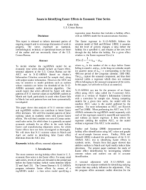
An official website of the United States government
Here’s how you know
Official websites use .gov
A .gov website belongs to an official government organization in the United States.
Secure .gov websites use HTTPS
A lock (
) or https:// means you’ve safely connected to the .gov website. Share sensitive information only on official, secure websites.
-
//
- Census.gov /
- Library /
- Census Working Papers /
- Issues in Identifying Easter Effects in Economic Time Series
Issues in Identifying Easter Effects in Economic Time Series
Issues in Identifying Easter Effects in Economic Time Series
Abstract
To decide whether the regARIMA model for an economic time series should include an Easter effect, seasonal adjusters at the U. S. Census Bureau use the AICC test in X-12-ARIMA (based on Akaike’s Information Criterion corrected for sample size), along with subject matter information. However, the AICC test may be sensitive to model problems such as outliers whose t-statistics are below the threshold of the X-12- ARIMA automatic outlier detection algorithm. One would expect that series affected by Easter will show patterns of X-11 extreme values or regARIMA outliers in March and April, particularly in years when Easter falls in March, but such patterns have not been systematically investigated.
This paper shows that analysis of X-11 extreme values and regARIMA outliers can contribute to better Easter effect decisions. We will first examine patterns of these outlying values in synthetic series with known Easter effects. We will then consider two sets of Census series: retail sales series, for which there is a generally accepted economic rationale for an effect in the week before Easter; and manufacturing shipments series, for which Easter effects have not been investigated as thoroughly. We will show that X-11 extreme values in March and April are useful in identifying false Easter effect detections from the AICC test.
Others in Series
Working Paper
Working Paper
Working Paper
Share
Related Information
Some content on this site is available in several different electronic formats. Some of the files may require a plug-in or additional software to view.
 Yes
Yes
 No
NoComments or suggestions?


Top

